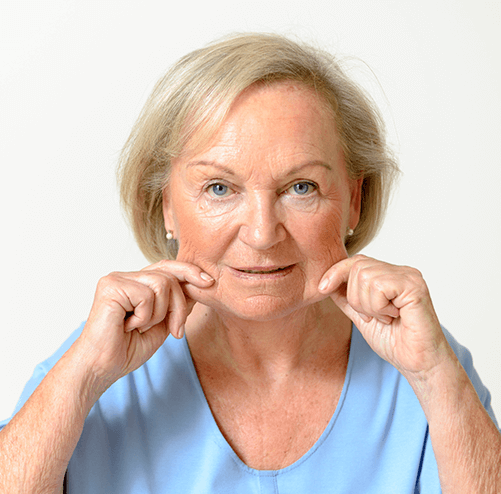Jowls: Causes, Prevention, & Treatments

The lower face tends to be one of the first facial areas to show the signs of aging. Over time, many people will experience sagging of the skin along their jawline which can dramatically alter the silhouette of their chin and upper neck.
What are Jowls?
Jowls is a term that refers to the excess droopy skin that collects along the lower part of the face, specifically along the jawline and below the cheeks. Sagging of the area fundamentally alters the naturally crisp contour of the chin and jawline transition into the upper neck. Typically, the jawline appears lower than before and many people notice more pronounced folds that develop along either side of the mouth (from the nose to the lips) called the nasolabial folds.
Nearly everyone will develop some degree of jowls as they age. However, individuals will differ in terms of how pronounced their jowls are based on genetics and lifestyle choices.

An example of severe jowls
Common Causes of Jowls
Loss of Skin Proteins
The specific cause of jowls formation is the thinning of the skin and the loss of skin elasticity. The root of both issues is a drop in the levels of two key structural proteins found in the body’s connective and muscle tissues: collagen and elastin. Both collagen and elastin are responsible for maintaining the integrity of the skin, upholding its strength and elasticity.
With natural aging, however, comes a decrease in the production of these skin proteins resulting in a weaker skin structure. The skin along the cheeks and around the mouth gradually lose their firmness. Eventually this area begins to sag or descend due to the pull of gravity.
Genetics
Like many other health issues, genetics can play a key role in how pronounced your jowls will become as you age. Individuals who naturally have more collagen, more facial fat, and thicker skin will usually have less noticeable jowls. People with naturally thin skin and lower collagen and elastic levels can expect their jowls to be more pronounced. One way to get a feel for how you may age is to look at your parents. The degree of visibility of your mother or father’s jowls is a great predictor of what you can expect.
Lifestyle Causes
There are some common behaviors and habits that can influence both the rate and severity of jowl development. These include:
- UV Exposure: Skin with excessive exposure to UV rays from the sun experiences severe collagen damage and early onset aging, leading to sagging skin. This is one more reason why practicing proper sun care is so important.
- Weight Changes: Dramatic fluctuations in weight can lead to a degradation in the strength and structure of the skin. For example, gaining body weight typically equates to stretching of the skin. If one loses this weight their skin will often be unable to fully snap back into its original place leading to sagging.
- Facial Expressions: Frequent common facial expressions like puckering of the lips or yawning can result in stretching of the skin along the jaw and chin. It’s one of the reasons why many skin care experts recommend not drinking through straws.
- Smoking: As discussed in this previous blog post smoking is terrible for the skin. In addition to the constant puckering expression which can lead to sagging of the skin, cigarettes contain numerous chemicals that damage collagen and elastin. Smoking also limits blood circulation, which in turn limits the ability of the skin to remain healthy.
- “Tech Neck”: Looking down for long periods of time while using a laptop or phone can lead to a loss of elasticity over time, along with stress injuries and muscle strain (commonly referred to as tech neck).
Jowls Prevention
While jowl formation is inevitable and many factors that cause jowls like genetics are out of your control, there are some ways to help prevent early jowl formation and minimize how pronounced the jowls will become. Here are some preventative tips:
- Practice Sun Safety: Always wear a broad-spectrum high SPF sunscreen, even on cloudy days. Also, avoid being outdoors during peak UV hours and wear a large hat or sun protective clothing.
- Don’t Smoke: Staying smoke free will help prevent early aging of the skin. If you currently smoke, consider quitting and follow these tips to improve your skin.
- Ergonomics: When using your phone or computer make sure to keep your head at a natural angle. Limit periods of looking downward to 10 minutes maximum.
- Stretching & Exercise: There are various at-home exercises that can be done to strengthen, tighten, and firm muscles in the cheeks, chin, and jawline. Regularly performing these exercises can strengthen the “scaffolding” structures under your skin which can help combat the effects of sagging.
Treatment of Jowls
There are several effective treatment options for addressing jowls. Individuals who exhibit early (minor) signs of jowl formation can benefit from a variety of non-surgical cosmetic procedures like fillers and laser treatments, while those with more pronounced jowls may require surgical intervention. Please see this blog post for more information on jowl treatment options.
